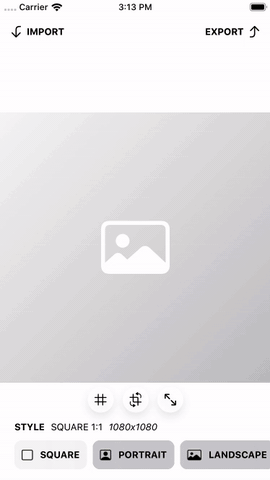Let’s see how we can bridge SwiftUI and UIKit to allow ourself to use UIImagePickerController which gives us the ability to let the user select a photo from his photo library.

This is a common problem with the first version of SwiftUI that we have today, we would still have to request and use some API that are only available in UIKit. We already saw how to do similar things to use MapKit, Apple have a tutorial to interface with UIPageViewController but here we will only focus on UIImagePickerController.
Introduce UIViewControllerRepresentable
First, you need to create a new struct that will conform to UIViewControllerRepresentable which is the protocol to implement when we need to interface/integrate with a UIViewController from UIKit.
struct ImagePickerViewController: UIViewControllerRepresentable {
}This protocol require us to provide:
- A function
makeUIViewController(context:)to initialize our UIImagePickerController instance. It’s called once when needed to be displayed. - A function
updateUIViewcontroller(_: context:)to update the instance of UIImagePickerController which we don’t need in this example. - A nested
class Coordinatorto communicate with UIKit, in this example it will be the one conforming toUIImagePickerControllerDelegate.
The protocol also have a default implementation of
- A function
makeCoordinator()that we will override to provide our custom nested Coordinator.
Initialization of the ImagePicker
struct ImagePickerViewController: UIViewControllerRepresentable {
@Binding var presentationMode: PresentationMode
@Binding var image: UIImage?
func makeUIViewController(context: UIViewControllerRepresentableContext<ImagePickerViewController>) -> UIImagePickerController {
let imagePicker = UIImagePickerController()
imagePicker.sourceType = UIImagePickerController.SourceType.photoLibrary
imagePicker.allowsEditing = false
imagePicker.delegate = context.coordinator
return imagePicker
}
func updateUIViewcontroller(_ uiViewController: UIImagePickerController, context: UIViewControllerRepresentableContext<ImagePickerViewController>)Here we just conform to the protocol by implementing the required methods. We also added a @Binding var presentedMode: PresentationMode to let us dismiss this ViewController when user has selected an image. That’s also why we have an optional binding to a UIImage that represent the selected image.
A Coordinator to implement UIImagePickerControllerDelegate
// Override the default implementation to use our Coordinator
func makeCoordinator() -> Coordinator {
return Coordinator(self) // Inject ImagePickerViewController in the Coordinator
}
// Nested class inside ImagePickerViewController
class Coordinator: NSObject: UIImagePickerControllerDelegate, UINavigationControllerDelegate {
var parent: ImagePickerViewController
init(_ parent: ImagePickerViewController) {
self.parent = parent
}
func imagePickerController(_ picker: UIImagePickerController, didFinishPickingMediaWithInfo info: [UIImagePickerController.InfoKey : Any]) {
let imagePicked = info[.originalImage] as! UIImage
parent.image = imagePicked
parent.presentationMode.dismiss()
picker.dismiss(animated: true, completion: nil)
}
func imagePickerControllerDidCancel(_ picker: UIImagePickerController) {
parent.presentationMode.dismiss()
picker.dismiss(animated: true, completion: nil)
}
}If you have already use UIImagePickerControllerDelegate there’s nothing really surprising, we have a delegate with a method to handle a success (when user did select) and another method to handle a cancel. In both situation, we dismiss both the UIImagePickerController itself along with our ImagePickerController.presentationMode.
In case of success, we assign to the ImagePickerController the image picked by the user.
Wrap it in a View
We are already almost done here but in order to use the ImagePickerViewController we need to wrap everything in a view so that any view from SwiftUI can use the picker immediately and easily.
struct ImagePicker : View {
@EnvironmentObject var userData: UserData
@Environment(\.presentationMode) var presentationMode
var body: some View {
ImagePickerViewController(image: $userData.image, presentationMode: presentationMode)
}
}
final class UserData: ObservableObject {
@Published var image: UIImage? = nil
}
struct ContentView: View {
@EnvironmentObject var userData: UserData
@State var pickerIsActive: Bool = false
var body: some View {
NavigationView {
if userData.image != nil {
Image(uiImage: userData.image!)
}
Button(action: {
self.pickerIsActive = true
}) {
Text(“Import image”)
}
.sheet(isPresented: $pickerIsActive) {
ImagePicker().environmentObject(self.userData)
}
}
}
}In that example, we use the ImagePicker as the content of a sheet() which will show the picker in the new iOS13 card modal presentation. And we keep track on the state with pickerIsActive.